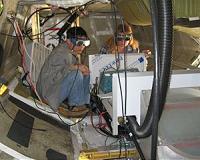 |
Redondo Beach CA (SPX) May 12, 2011 Northrop Grumman and Applied Minds have announced the success of a recent launch and orbit of a Mayflower test microsatellite. Data gathered from around the world was analyzed, showing all tested systems functioned correctly including a new, previously unproven advanced solar cell deployment system. While this first flight collected baseline design data, subsequent flights at higher altitudes will demonstrate unique propulsion, communication and orientation capabilities, and novel payloads. "Microsatellites are an important part of our future in advancing and maturing technologies," said Paul Meyer, vice president and general manager of advanced programs and technology at Northrop Grumman Aerospace Systems. "We are pleased to be working with Applied Minds to develop the technologies that will make microsatellites successful, and make space mission participation more accessible to nontraditional partners." The satellite, launched on Dec. 8, 2010, was the first commercial cubesat deployed into orbit by SpaceX. A cubesat is a type of miniaturized spacecraft used for research. Mayflower was launched on a Falcon 9 Dragon test mission and successfully injected into an elliptical orbit approximately 285 kilometers above earth. The system was designed to test a set of microsatellite components in space. Following standard specifications, microsatellites easily combine with one another onto existing rockets, and only require low development costs, making space mission participation more accessible to those outside the industry. Mayflower and other microsatellites are being jointly developed by Applied Minds and Northrop Grumman, expanding the types of payloads on satellites, and consequently, the types of missions completed by satellites. Built at Applied Minds in 2010, Mayflower and a payload designed by the University of Southern California were integrated and tested at Northrop Grumman, and then integrated into the Falcon 9 Dragon test mission by California Polytechnic State University, San Luis Obispo. Communications from Mayflower were received at numerous locations around the world and collectively analyzed by NovaWorks, an innovation center for development and operations at Northrop Grumman. Mayflower is serving as the technology development forerunner for other space products at NovaWorks. "This was an exciting mission for us, and we are proud to be SpaceX's first nongovernment customer," said Danny Hillis, co-founder of Applied Minds. "We hope to launch many more satellites with them in the future." Applied Minds invents, designs, creates and prototypes high technology products and services for a broad range of commercial and government applications including aerospace, transportation, education, architecture, distance collaboration, advanced visualization, electronics and software.
Share This Article With Planet Earth
Related Links - Space Technology News - Applications and Research
 Broadband Lidar Instrument Successfully Tested on NASA's DC-8
Broadband Lidar Instrument Successfully Tested on NASA's DC-8Greenbelt MD (SPX) May 11, 2011 How do instruments end up on satellites orbiting the Earth? For many of them, long before they are ever launched into space, they are tested from NASA airplanes. One of the objectives of the NASA Airborne Science Program is to test new instruments in space-like environments. Testing future satellite instruments from airplanes is the next best thing to actually testing them in space. Over t ... read more |
|
| The content herein, unless otherwise known to be public domain, are Copyright 1995-2010 - SpaceDaily. AFP and UPI Wire Stories are copyright Agence France-Presse and United Press International. ESA Portal Reports are copyright European Space Agency. All NASA sourced material is public domain. Additional copyrights may apply in whole or part to other bona fide parties. Advertising does not imply endorsement,agreement or approval of any opinions, statements or information provided by SpaceDaily on any Web page published or hosted by SpaceDaily. Privacy Statement |